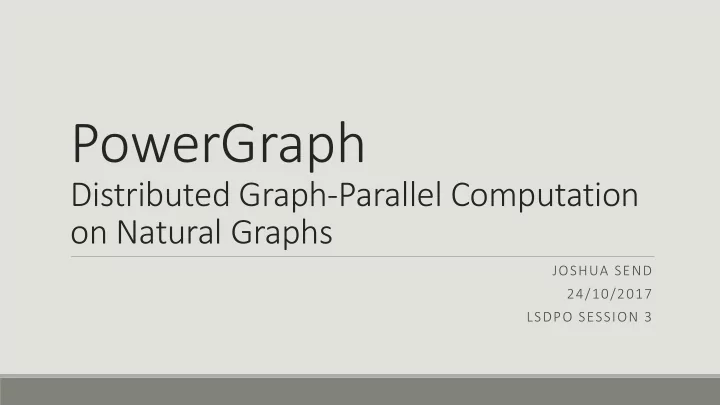

PowerGraph Distributed Graph-Parallel Computation on Natural Graphs JOSHUA SEND 24/10/2017 LSDPO SESSION 3
Intuition for Graph Processing Systems Overall goal • efficiently compute over large graphs of data – key is distributing work Typical tasks: Single Source Shortest Path, PageRank etc. Approach • Define computation graph on the data rather than passing graph through computation steps
Existing Systems – Pregel [1] Input data graph • Assign computation to each vertex, vertices to instances Synchronous supersteps Directed Edges
Existing Systems – GraphLab [2] Also facilitates processing large graphs of data and distributes graph vertices to instances No explicit message passing and directed edges Asynchronous execution – no supersteps
Motivation ◦ Power Law connectivity: P(d) ∝ d −α ◦ Eg. Social networks, internet ( α ≈ 2)
Natural Graphs
Contributions 1. Generalized “vertex program” 2. Distribute graph edge-by-edge rather than vertex- by-vertex 3. Practical parallel locking
Generalized Vertex Program Apply • Collect data and • Disseminate to aggregate neighbors • Perform • Commutative, • Activate their operation on associative operation gathered data aggregator Gather Scatter
SSSP
Vertex Splitting Standard approach – assign each vertex of graph to an instance – often requires ‘ghosts’ Idea – assign each edge to an instance Leads to vertices appearing on different instances Parallelization of data gathering and scattering “within” one vertex as edges may be in different instances Set of instances containing a particular vertex called replicas and randomly assign a master, rest are called mirrors Master receives partial aggregations, applies vertex operation, sends changes to edges to scatter
Master, Mirrors
How to actually distribute Edges 3 different strategies 1. Random ◦ Deploy edge to instance based on hash 2. Greedy Heuristic ◦ Reduce number of replicas per vertex ◦ Requires estimate of sets of replicas per vertex
Heuristic Distribution 1. Oblivious ◦ Estimate sets from local information only ◦ Paper unclear on how exactly this works 2. Coordinated ◦ Keep distributed table of sets replicas per vertex Tradeoff space: longer load time vs. fewer replicas & faster execution
Execution Stategies Supports: ◦ Synchronized supersteps (à la Pregel), ◦ Asynchronous ◦ Asynchronous + serializable utilizing parallel locking Tradeoff space: predictability/determinism vs throughput vs runtime/convergence speed
Miscellaneous Delta Caching ◦ Update edges with deltas rather than rewriting values. If delta is 0, neighbor may not have to recompute Fault Tolerance ◦ Checkpointing
Results Partitioning scheme ◦ Random > oblivious > coordinated in terms of replication factor ◦ All faster than Pregel/Piccolo and GraphLab for synthetic natural graphs Execution Strategy ◦ Synchronized: 3-8x faster implementing PageRank than on Spark per iteration ◦ Async : Even faster (authors don’t provide a direct comparison?) ◦ Async + Serializable: less throughput, converges faster (less recomputation)
Remarks Paper’s details are hard to understand Evaluation is a bit sloppy – missing some direct comparisons between execution strategies and combinations of partitioning and execution Large tradeoff space, hard to navigate o Eg. Coordinated distribution can increase load times 4x o Authors highlight 60s vs 240s for random vs coordinated partitioning o Meanwhile, SSSP on 6.5B edges takes 65s to run
Remarks Solid theoretical foundation for partitioning heuristic Very solid gains over prior systems, especially in tasks with natural graphs!
References 1. G. Malewicz, M. Austern, A. Bik, J. Dehnert, I. Horn, N. Leiser, and G. Czajkowski: Pregel: A System for Large-Scale Graph Processing, SIGMOD, 2010. 2. Y. Low, J. Gonzalez, A. Kyrola, D. Bickson, C. Guestrin, J. Hellerstein: Distributed GraphLab: A Framework for Machine Learning and Data Mining in the Cloud, VLDB, 2012. 3. J. Gonzalez, Y. Low, H. Gu, D. Bickson, and C. Guestrin: Powergraph: distributed graph-parallel computation on natural graphs. OSDI, 2012.
Recommend
More recommend